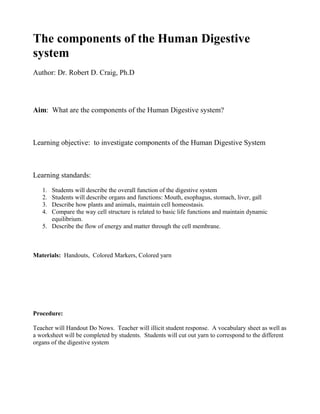
Digestivesystem lessonpla nnew
- 1. The components of the Human Digestive system Author: Dr. Robert D. Craig, Ph.D Aim: What are the components of the Human Digestive system? Learning objective: to investigate components of the Human Digestive System Learning standards: 1. Students will describe the overall function of the digestive system 2. Students will describe organs and functions: Mouth, esophagus, stomach, liver, gall 3. Describe how plants and animals, maintain cell homeostasis. 4. Compare the way cell structure is related to basic life functions and maintain dynamic equilibrium. 5. Describe the flow of energy and matter through the cell membrane. Materials: Handouts, Colored Markers, Colored yarn Procedure: Teacher will Handout Do Nows. Teacher will illicit student response. A vocabulary sheet as well as a worksheet will be completed by students. Students will cut out yarn to correspond to the different organs of the digestive system
- 2. Teacher Guide (Say aloud) The digestive system is comprised of a group of organs working together to break down foods into a form usable by the human body. This system is composed of organs through which the food passes (alimentary canal) and organs such as the liver, pancreas, and gall bladder that provide chemical substances such as enzymes needed for chemical digestion. The organs that make up the alimentary canal are the mouth, esophagus, stomach, small intestine, large intestine, and anus. Digestion begins in the mouth, where mechanical (digestion such as the tearing, cutting, and grinding of food by the teeth) and chemical (type of digestion that breaks down large molecules into molecules small enough to dissolve in water and pass through cell membranes) digestion occurs. From here the food is then moved down the esophagus by a process called peristalsis (the wavelike contraction of the walls of the esophagus that forces the food through the esophagus). Once food leaves the esophagus, it enters the stomach through the cardiac sphincter (a circular valve of muscle that works like a drawstring on a sack). The stomach, a jshaped organ, continues the chemical and mechanical digestion of food. Digestive enzymes secreted by the gastric glands in the lining of the stomach continue the further chemical digestionof food. Once the food has been changed into a thick liquid known as chyme, it moves from the stomach through the pyloric sphincter into the small intestine. Secretions from the pancreas and liver aid in completing the chemical digestion. The capillaries located in the villi of the smallintestine absorb nutrients (digestive foods). Materials not absorbed by the villi will then enter the large intestines, where reabsorption of water occurs, producing semisolid feces. Waste will then be eliminated from the body through the anus. Demo procedure: How Long is the Digestive System? Have students cut a piece of yarn according to the following measurements. Allow students to use different color yarn to represent different organs. After the yarn has been cut tie the pieces together. • Esophagus 10 inches • Stomach 8 inches
- 3. • Small Intestine 275 inches • Large Intestine 60 inches • TOTAL 353 inches (almost 30 feet) Assessment: Students will have a discussion and complete the following questions:
- 4. HARLEM CENTER FOR EDUCATION: Digestive system Name:________________________ Period:______________ Date:_________ What is Mechanical Digestion? (give two examples) 1.__________________________________________________ 2.__________________________________________________ What is Chemical Digestion? (give two examples) 1.__________________________________________________ 2.__________________________________________________
- 5. Student Handout: Digestive system Mouth Mechanical Digestion Teeth: 4 Types Molars, Pre-molars, canines and tricuspids Hold, Tear, and Chew Food Tongue: Moves food mass “bolus” to rear of mouth Chemical Digestion: Saliva - Enzyme: Amylase Amylase: Breaks down starches to disaccharides Enzyme: a protein that acts as biological catalyst Esophagus: Food tube Epiglottis: closes over trachea to prevent food from going down air way. Peristalsis: contractions of smooth muscle surrounding the esophagus. When you bite into apple, what teeth do you use
- 6. HARLEM CENTER FOR EDUCATION Name: ________________________________________Period: ___________________________ 1. Class Room Teacher: _____________________________________________________________________________ 1 Find the digestive system words below in the grid to the left. 2 3 4 5 6 7 8 9 10 11 12 13 14 15
- 7. Across Down 2. A long folded tube inside the body attached to the 1. After being swallowed, food goes to this place stomach where nutrients in the food are absorbed. where it is mixed with acid. 6. A part of your throat that acts like a gateway 3. The tube after the small intestine where liquid is sending air into the lungs and food down into the absorbed. stomach. 4. These are used to chew food. 7. The place where waste is stored before it leaves 5. The good things in food. the body. 9. A slippery liquid that makes food easy to swallow 8. The part of the food that is not digested. and helps to break the food down. 11. The tube that connects the stomach to the 10. The process of breaking down food for use as mouth. energy and building materials for your body. 12. A verb that means to push food through your 13. This produces juices (called bile) that go into the pharynx. small intestine and help digest the food. 14. Crush food with your teeth. 15. Muscle in your mouth that is used for pushing food around. © 2006 www.bogglesworldesl.com
- 8. Assessment: Name:________________________ Period:______________ Date:_________ 1. What enzymes are need for digestion? 2. What is the pH of the Stomach? 3. What is the acid in the stomach
- 9. Name:________________________ Period:______________ Date:_________ Please define the following: Pancreas: ________________________________________________________________ ________________________________________________________________ Liver: ________________________________________________________________ ________________________________________________________________ Gall Bladder: ________________________________________________________________ ________________________________________________________________ Small Intestine: ________________________________________________________________ ________________________________________________________________ Large Intestine: ________________________________________________________________ ________________________________________________________________
